|
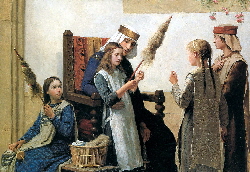 There are many styles of distaffs and several different ways of using them. Patricia Baines wrote a wonderful book ‘Linen Hand Spinning and Weaving’ where you can find more detailed information on using distaffs. There are many styles of distaffs and several different ways of using them. Patricia Baines wrote a wonderful book ‘Linen Hand Spinning and Weaving’ where you can find more detailed information on using distaffs.
Many spinners find it easier to spin from a distaff that has been well-dressed with criss-crossed fibres (e.g. a cone, lantern, truncheon or board distaff) than from a distaff where the fibres that are parallel to each other (pole, comb or towel). Distaffs with parallel fibres, however, are easier and quicker to dress.
A) Distaffs with criss-crossed fibres
|
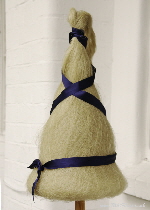
|
|
dressed Cone distaff
|
|
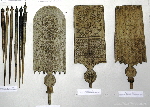
|
|
Board distaffs
|
|

|
|
Russian distaffs
|
|
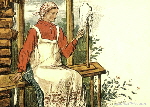
|
|
using Russian distaff
|
|
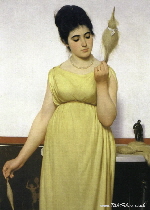
|
|
using Stick distaff
|
|
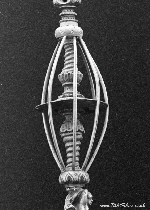
|
|
Lantern distaff
|
|
1) Cone distaff
2) Lantern distaff
3) Truncheon distaff
4) Bat or board distaff
5) Russian distaff
B) Distaffs with parallel fibres
6) Pole or stick distaff
7) Comb distaff
8) Towel distaff
Gallery of Distaff Types
A) Distaffs with criss-crossed fibres
1) Cone distaff
This is the usual type of distaff used with spinning wheels. According to Baines, “they are the ideal shape for dressing with fibres pre-arranged to criss-cross with each other. The flair at the bottom of the distaff helps to hold back the fibres, preventing them from coming down in too much quantity and too quickly.’ Cone distaffs are often made of wood to match the flax spinning wheel. However, you can easily make your own cone distaff with paper, see the instructions here.
2) Lantern distaff
A lantern distaff (also known as a bird-cage distaff) is traditionally made by bending thin branches upwards and tying them together. Thick basketry reed or thin willow can also be used to make the ribs. This type of distaff comes in many shapes and sizes. Fibre is wrapped round the cage at right angles to the cage. You can use the same method described for the truncheon distaff below. When you finish spinning, leave some fibres round the cage as this will make it easier for you to dress the distaff the next time. The new fibres will ‘stick’ to the old ones.
3) Truncheon distaff
The truncheons are between 30 and 45 cm long and the name describes the shape well. Truncheon distaffs are found in Scandinavia. The flax is rolled at right angles to the truncheon. Baines describes how to dress this distaff as follows:
- Remove a finger of flax from your strick and place it on a table.
- Make a ‘U’ shape with the strick.
- Place one hand over both legs of the ‘U’.
- With the flat of your hand on the table, gently pull some fibres from the curve of the ‘U’ and roll then on the distaff
- Continued to pull fibres and roll round the distaff so they overlap each other horizontally. Do not roll too tightly or it will be impossible to draft.
4) Bat or board distaff
This is usually a rectangular or oval flat piece of wood, sometimes with 3 holes down the centre or small notches on the side to hold the ribbon in place. To dress this distaff spread a small layer of flax on a table, little by little spread more layers one on top of the other. Then roll the flax into a large bat and tie it to the distaff.
5) Russian distaff
This is an L-shaped variation of the board distaff which has two pieces: a horizontal board for sitting on and a vertical flat piece. The flax is attached to the inside of the vertical piece. This type of distaff is often elaborately carved and painted with bright colours.
Back to Top
B) Distaffs with parallel fibres
6) Pole or stick distaff
This is the simplest and most portable of distaffs. It is tucked in a belt and held under the arm. A stick distaff used with a drop spindle is usually about 90 cm long. The stick needs to be very smooth, so the flax fibres do not catch on it. Make a small notch around the stick about 3 cm from the top to tie the ribbon. This distaff is very easy to dress, just fold the strick in a ‘U’ shape and tie both ends of the strick on the notch. Alternatively just tie one end of the flax strick at the notch so the fibres hang straight from the top.
You will find it easier to spin if you open up the strick before you dress the pole distaff. To do that, grab a finger’s width of fibre from the strick and hold it firmly, with one hand on each end of the strick. Shake the strick gently but rapidly, being careful that the bundle of flax does not fall apart.
If you want a pole distaff that can be taken on public transport, a folding walking stick is a great alternative.
7) Comb distaff
This consists of a narrow board with a set of teeth at the top. Comb distaffs can be elaborately carved and they are found in north-east and east Europe (e.g. Sweden and Russia). They are easy to dress: shake the flax (as described above) and then pull one end firmly over the comb to anchor it. If you have grown your own flax, place the thicker root ends over the comb.
8) Towel distaff
You can also wrap a terry towel round a bundle of flax leaving the end of the bundle exposed. Hold the towel over your shoulder or on your lap while you spin.
Types of Flax Distaff - gallery of photos (click to enlarge!)
Next:-
Spinning flax & flax distaffs
a) Types of flax distaff
b) Making a cone distaff
c) Preparing flax for the distaff
d) Dressing a flax distaff
e) Spinning flax from a distaff (in preparation)
Top of page
|

